AMD vs. Intel Performance
At this point it's not too big of a surprise that AMD is the stronger performer when it comes to gaming performance. It's actually at the point where even insiders at Intel will admit and recognize that Intel is no longer the king of gaming performance as they once were long ago. But how bad is it under Half Life 2? Let's take a look at our five custom demos to find out.
We used the current king of Half Life 2 performance for all of our CPU tests - the ATI Radeon X850 XT Platinum Edition running at 1280 x 1024, to give a good balance between CPU and GPU limitations while providing realistic performance figures. Note that all of the Intel CPUs tested here are LGA-775 and all of the AMD CPUs are Socket-939.
First we have at_canals_08, generally a good GPU test, meaning that its CPU dependency is minimized. The benchmark includes a decent number of NPCs and firefights but is severely offset by things like water and flashlight usage, both of which are more GPU intensive elements of the benchmark.
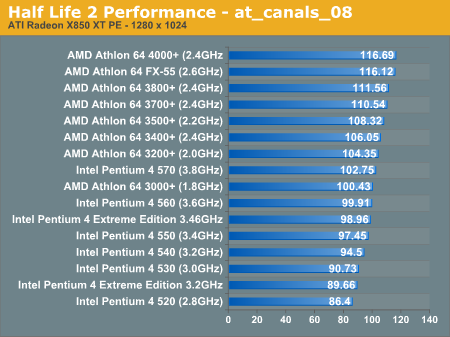
Things don't look so good for Intel here, the Pentium 4 570J is the only Intel CPU capable of outperforming the Athlon 64 3000+. Unfortunately for Intel, AMD's Athlon 64 4000+ is about 14% faster at 1280 x 1024.
The Extreme Edition CPUs don't do much for Intel, as Prescott does appear to perform equal or better clock for clock than the older Northwood core.
Next let's take a look at at_coast_05, another very GPU limited test that has a good deal of NPC interaction as well as GPU limiting elements:
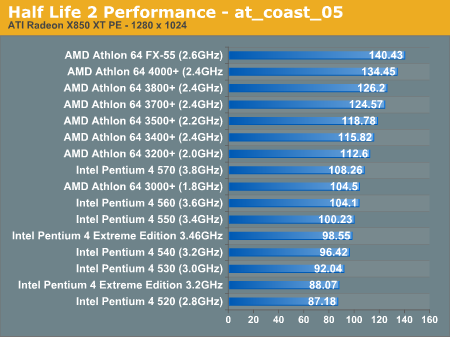
The results here are very similar to what we saw under at_canals_08, with the Pentium 4 570J offering performance slightly higher than the Athlon 64 3000+ but that's about it for Intel. The Athlon 64 4000+ is an impressive 24% faster than Intel here which honestly is nothing to scoff at.
Our next demo, at_coast_12, doesn't change much either:
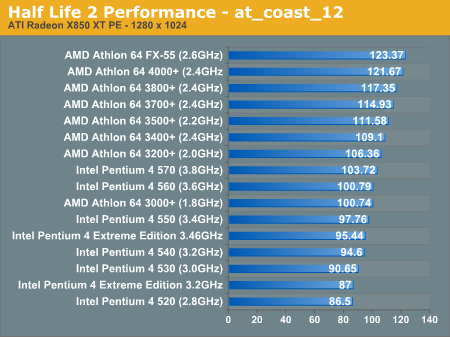
The performance under at_prison_05 is a little closer:
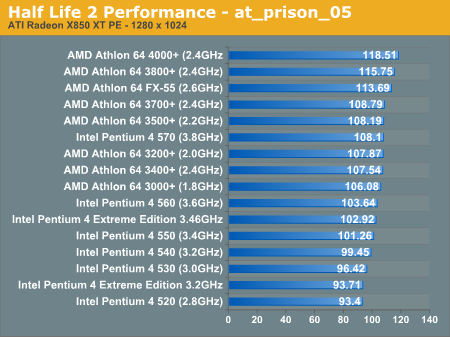
Finally we have an excellent CPU benchmark, at_c17_12. The test is extremely CPU bound, and thus makes the perfect conclusion to this section:
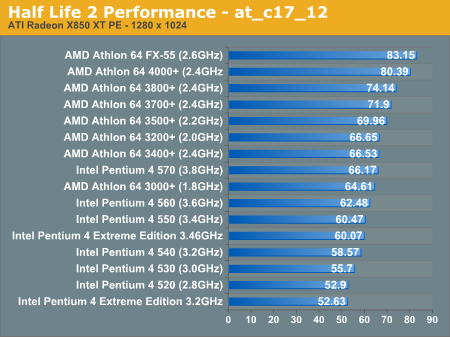
While you can argue that AMD's performance advantages in the other tests aren't noticeable on a price-for-price basis, you can't argue with the results here. At the $280 - $290 price point, AMD's Athlon 64 3500+ delivers about 15% more performance than Intel's Pentium 4 550.
The margin is even greater at the low end, AMD's Athlon 64 3000+ is 23% faster than Intel's similarly priced Pentium 4 520.
At the high end the advantage is equally in AMD's favor, with the Athlon 64 4000+ holding a 22% advantage over Intel's fastest Pentium 4.
Conclusion? Don't look any further than AMD for the best gaming CPU, and Half Life 2 further cements AMD's reputation as the gamer's CPU.










68 Comments
View All Comments
Roooooooooooooooooot - Wednesday, January 26, 2005 - link
Ommmmm ... yes, a very nice article :)
More than any article I've seen, this one made the point about the power of AMD processors for 3D gaming.
"Megahertz Shmegahertz" could have been the title. The 3.8 Pentium running neck and neck with a 2 GHz AMD CPU. Now I understand !!
One place I worked had hundreds of Dell Workstations. They gave us dual xeon ultra-SCSI jobbies. It may not sound like much, but 2 1 GHz Xeon's with an 18 Gig U160 or was it 320 SCSI HDD and an ATI FireGL graphics card was what I had.
I would love to see an article about corporate CAD machines, AMD vs. Intel with various scales of video cards.
bamacre - Wednesday, January 26, 2005 - link
1,000,001 demands for A XP benchies, how about one for high-end Northwood P4's ?? Please?AkumaX - Wednesday, January 26, 2005 - link
I one MEELIONTH the motion, i wish there were a XP barton benchmark somewhere in there, not just w/ the XP3200 (2.2ghz) but also w/ 2.3ghz and 2.4ghz (since most of us appear to also be running o/ced mobiles :P)michael2k - Wednesday, January 26, 2005 - link
What did you expect? People were demanding the HL2 CPU article in the Mac threads... and lo and behold, the next day, Anand has posted the HL2 CPU article.You can either get something now, or you can get something finished... very rarely can you get both :)
Crassus - Wednesday, January 26, 2005 - link
I was also quite surprised that the article still appeared. I'm glad it did, but I think it falls short of Anandtechs high standard:1. For comparison, at least two AXP (two to see how it scales) should be in the test field
2. As previously mentioned, Processor/speed/cache/socket. There is more that just one Athlon 64 3000+
3. Including CAS 2,5 would have been nice as this seems to be the default for people using mainstream DDR3200 RAM
4. What's the deal with the Athlon 3500+ in diagramm 3 on page 2?
Something else bothered me:
Quote: "If you are stuck with one of those older but still well-performing GPUs, don't bother upgrading your CPU unless it's something slower than a 2.4GHz Pentium 4 - you'd be much better served by waiting and upgrading to dual core later on."
Common wisdom seemed to be that especially games don't take advantage of multi-threading. Do you have any new information that upcoming games are geared more towards multiple CPUs/cores/HT?
quanta - Wednesday, January 26, 2005 - link
The test didn't show the impact of using partial precision vs full precision on NVIDIA cards. As some people have mentioned[1], Half-Life 2 doesn't need full 32-bit precision to run smoothly. In effect, NVIDIA card is running in speed crippled by the game's designers.[1] http://3dgpu.com/archives/2004/12/01/boost-perform...
DavidHull - Wednesday, January 26, 2005 - link
I second the need for SLI configurations to be included, as many reviewers have found them to be extremely limited by the CPU.AtaStrumf - Wednesday, January 26, 2005 - link
Interactive 3D charts in flash. Khm,... can it be done?AtaStrumf - Wednesday, January 26, 2005 - link
I was starting to think this article has been bined, but fortunately it wasn't.First of all I agree with the need for an AXP 3200+ in the charts. It's still a very, very common PCU!
Secondly this is only an OK article by Anand's standards. The first thing that really bothered me was how the CPU's are marked by some very long but also very useless names, like
AMD Athlon 64 3400+ (2.4 GHz)
Intel Pentium 4 570 (3.8 GHz)
This takes a lot of room on the carts but still tells me nothing about Cache size or Socket type. I suggest names like:
A64 3400+/S754/512kB/2.4GHz (its shorter and says a lot more)
Same thing for Intel: P4 570/Socket/Cache...
And how in the hell did you come up with CAS3? Most DDR 400 RAM (excluding OEMs) is CAS 2,5 and not 3 or 2. I appreciate the memory tests very much though, I just regret the very basic mistake in the underlaying assumptions.
I understand it was a low priority, seriously delayed article, but I just can't shake the feeling it could have been so much more.
One of these days I'm gonna have to take some time and put together a demo of how data is properly presented.
Questar - Wednesday, January 26, 2005 - link
"Next let’s take a look at at_coast_05, another very GPU limited test that has a good deal of NPC interaction as well as GPU limiting elements:"
How the hell could this be GPU limited if the difference from top to bottom of the graph is > 50%?